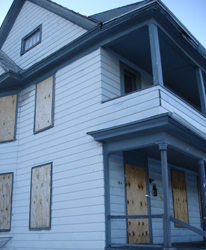Ed Duncan and Susan Squair fear for their safety in their Hope Avenue home in the city’s South Side.
The boarded-up vacant building next door, they say, has become a stash house for drug dealers.
“They tried to break into my house right before Christmas,“ Duncan said. “Smashed two windows out in the back.”
That fear of crime is just one reason that Syracuse residents like Duncan and Squair want the city to clean out or clean up the vacant houses plaguing neighborhoods like the South Side and the Near West Side.
The city’s lower-income neighborhoods, say their advocates, are especially afflicted with vacant, derelict buildings. “We’re about 15 percent of the city’s households,” said Phil Prehn, a community developer for Syracuse United Neighbors, a not-for-profit that advocates for community members in low-income neighborhoods. “Yet we have about 45 percent of the city’s vacant housing.”
Derelict structures affect the quality of life for entire neighborhoods, Prehn said. “Vacant houses create crime. They lower property values of other people. It makes it hard for them to get homeowners insurance,” he added.
As part of its crusade against abandoned buildings, Syracuse United Neighbors obtained a list of vacant structures from the city’s department of code enforcement. The lists shows 1,622 vacant properties in the city.
“That’s about 250 more than this same time last year. It seemed to be a precipitous jump,” said Kerry Quaglia, executive director of Home HeadQuarters Inc. It’s also a not-for-profit that works with low-income families to get affordable, safe housing.
For several years, not-for-profit groups and the city have concentrated on vacant housing and the problems they cause. A city government program allows not-for-profit organizations and for-profit companies to buy vacant structures with overdue taxes for $1. The city has also gained state approval, says Quaglia of HomeHeadquarters, to lock in property assessments for seven year or up to nine years for buildings that are renovated to meet energy-efficiency standards.
The administration of new Mayor Stephanie Miner is developing its own plans to deal with vacant housing, said Paul Driscoll, commissioner of the department of business and neighborhood development. “I’d be lying if I told you that we have it all figured out at this point,” Driscoll said. “But we are frantically working towards” a strategy to resolve the city’s long-standing problems of abandoned buildings.
Driscoll sees many of the vacant structures as assets, if they can be renovated. They add to the historic architecture and feel of Syracuse, Driscoll said. “We need to save this housing stock to market it to folks both in and out of the city,” Driscoll said.
For those houses that can be renovated, he said, the new city administration plans to help stop their deterioration. This might mean putting on a new roof or other weatherization measures while city officials and not-for-profit groups search for funds to renovate the buildings.
That would be a change in approach, said Driscoll. “We usually don’t touch a property unless we are going to demolish or rehab it,” Driscoll said. “And now we’re considering this interim phase.”
On Hope Avenue, Ed Duncan and Susan Squair still worry about the empty houses’ attractions to drug dealers and users. “They sit out on the porch in the summer and smoke pot,” said Squair. “If it wasn’t here they wouldn’t do that.”
The vacant house next to theirs on Hope Avenue is open to anyone who wants to get in. Its side door recently was broken in.
To make his neighborhood look better, Duncan sometimes mows the lawn of the vacant property in the summer. This winter, he had been shoveling the sidewalk in front of the house. Now he’s given up on that.
“I was shoveling,” Duncan said. “Then I said to hell with it.”
(Justin Sondel is a graduate student in magazine, newspaper and online journalism.)
-30-



